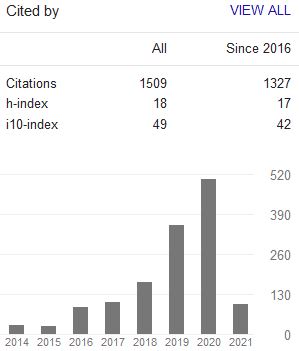GEERTZ’S TRICHOTOMY OF ABANGAN, SANTRI, AND PRIYAYI: Controversy and Continuity
Abstract
Keywords
Full Text:
PDFReferences
Bachtiar, Harsja W. “The Religion of Java: A Commentary.” in Readings on Islam in Southeast Asia, compiled by Ahmad Ibrahim, Sharon Siddique, and Yasmin Hussain. Singapore: ISEAS, 1985.
Baswedan, Anies R. “Indonesian Politics in 2007: The Presidency, Local Elections and the Future of Democracy.” Bulletin of Indonesian Economic Studies, 43:3 (2007): pp. 323–340.
----------. “Political Islam in Indonesia: Present and Future Trajectory.” Asian Survey, 44:5 (2004): pp. 669-690.
Beatty, Andrew. Varieties of Javanese Religion: An Anthropological Account. Cambridge: Cambridge University Press, 1999.
Bird, Judith. “Indonesia in 1998: The Pot Boils Over.” Asian Survey, Vol. 39: 1 (Jan. - Feb. 1999): pp. 27-37.
Burhani, Ahmad Najib. “Aksi Bela Islam: Konservatisme dan Fragmentasi Otoritas Keagamaan.” Jurnal Maarif, 11:2 (December 2017): pp. 15-29.
----------. “Kitab Kuning dan Kitab Suci: Membaca al-Jabiri dengan perspektif NU dan Muhammadiyah.” Jurnal Masyarakat Indonesia, Vol 41:1 (Juni 2015): pp. 29-42.
----------. “Transmission of Islamic Reform from the United States to Indonesia: Studying Fazlur Rahman’s legacy through the works of Ahmad Syafii Maarif.” Indonesia and the Malay World, 41:119 (2013): pp. 29-47.
Evans-Pritchard, E. E. Witchcraft, Oracles and Magic among the Azande. Oxford: Clarendon Press, 1976.
Fikri, Ahmad. “Muhammadiyah Tolak Hari Santri Nasional.” Tempo (15 October 2015), accessed on 20 October 2017 from URL: http://nasional.tempo.co/read/news/2015/10/15/078709737/muhammadiyah-tolak-hari-santri-nasional
Geertz, Clifford. The Religion of Java. Glencoe, Ill.,: Free Press, 1964.
Hefner, Robert W. Civil Islam: Muslims and democratization in Indonesia. Princeton, N.J.: Princeton University Press, 2000.
----------. Hindu Javanese: Tengger Tradition and Islam, Princeton, New Jersey: Princeton University Press, 1985.
Koentjaraningrat. Javanese Culture. Singapore: Oxford University Press, 1985.
Liddle, R. William and Saiful Mujani. “Leadership, Party, and Religion: Explaining Voting Behavior in Indonesia.” Comparative Political Studies, 40:7 (2007): pp. 832-857.
Machmudi, Yon. “The Emergence of New Santri in Indonesia.” Journal of Indonesian Islam, 2:1 (2008): pp. 69-102.
Mortimer, Rex. “Class, Social Cleavage and Indonesian Communism.” Indonesia, 8 (Oct. 1969): pp. 1-20.
Muhaimin, A.G. “The Islamic Traditions of Cirebon: Ibadat and Adat Among Javanese Muslims.” Unpublished PhD Thesis, The Australian National University, Canberra, 1995.
Nakamura, Mitsuo. The Crescent Arises over the Banyan Tree: A Study of the Muhammadiyah Movement in a Central Javanese Town. Yogyakarta: Gadjah Mada University Press, 1983.
Poensen, C. “Letters about Islam from the Country Areas of Java, 1886.” in Indonesia. Selected Documents on Colonialism and Nationalism, 1830-1942. ed. and trans. Christian Lambert Maria Penders. St. Lucia. Queensland: University of Queensland Press, 1977.
Ricklefs, M.C. The Seen and Unseen Worlds in Java, 1926-1949: History, Literature and Islam in the Court of Pakubuwana II. Honolulu: Allen & Unwin and University of Hawai’i Press, 1998.
Samson, Allan A. “Army and Islam in Indonesia.” Pacific Affairs, 44: (19724): pp. 545-565.
Sutherland, Heather. “The Priyayi.” Indonesia, Vol. 19 (April 1975): pp. 57-77.
Syamsuddin, Din. “Din Syamsuddin Tolak Hari Santri Nasional,” (16 October 2016), accessed on 20 October 2017 from URL: http://www.khittah.co/din-syamsuddin-tolak-hari-santri-nasional/1083/
Tanuwidjaja, Sunny. “Political Islam and Islamic Parties in Indonesia: Critically Assessing the Evidence of Islam’s Political Decline.” Contemporary Southeast Asia, 32:1 (2010): pp. 29–49.
Woodward, Mark R. Islam in Java: Normative Piety and Mysticism in the Sultanate of Yogyakarta. Tucson: University of Arizona Press, 1989.
----------. “Talking Across Paradigms: Indonesia, Islam, and Orientalism.” in Mark R. Woodward (ed.). Toward a New Paradigm: Recent Developments in Indonesian Islamic Thought. Tempe, Arizona: Arizona State University, 1996.
DOI: 10.15642/JIIS.2017.11.2.329-350
Refbacks
- There are currently no refbacks.
Indexed by:
Journal of Indonesian Islam (ISSN 1978-6301 and E-ISSN 2355-6994) is published by the Postgraduate Program (PPs) and the Institute for the Study of Religion and Society (LSAS), State Islamic University (UIN) of Sunan Ampel Surabaya.
Journal of Indonesian Islam by http://jiis.uinsby.ac.id/index.php/JIIs/index is licensed under a Creative Commons Attribution-ShareAlike 4.0 International License.
Copyright ©2020 State Islamic University (UIN) of Sunan Ampel Surabaya. Powered by Public Knowledge Project OJS.







